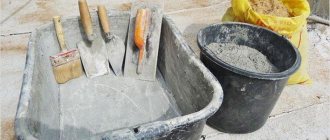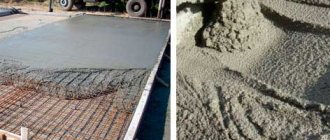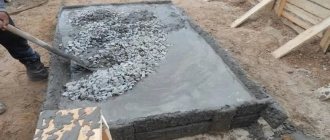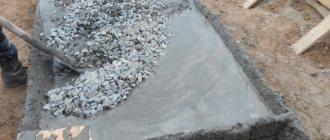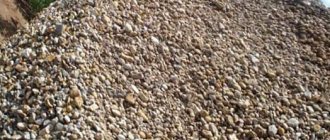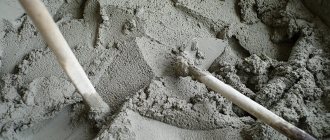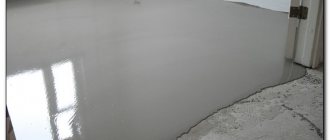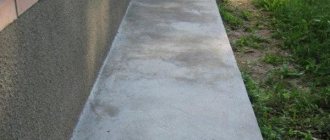The basis of any structure is its foundation. It must be reliable and durable. Only in this case will the building last for a long time. At the beginning of construction, it is necessary to correctly select the composition of cement that will be used and calculate the proportions of concrete for the foundation.
The grade of concrete is formed in accordance with the ratio of the components included in its composition, as well as such indicators as plasticity during laying. The consistency of the solution depends on the amount of water used in its preparation. The proportion of ingredients can be determined by their weight or volume. The most commonly used quantity of components is calculated using a scale or a bucket.
Composition of foundation concrete
Concrete is a mixture of binder and aggregate, which are diluted with a certain amount of water. To improve its quality, additional ingredients can be added to it.
Cement
This is the main component, the quantity of which determines the consistency. Several types of cement are known. Among the most frequently used are the following:
- Portland cement . The cement hardening time begins no earlier than 45-50 minutes after mixing it. The solution finally hardens after 5-10 hours.
- Portland slag cement . After preparing the solution, it begins to harden within 1-6 hours, depending on the air temperature or cement parameters.
- Pozzolanic . The hardening time occurs after 1-4 hours, and the cement finally hardens after 6-13 hours.
- Aluminous . Hardens in 60 minutes, and completely hardens no later than after 8 hours.
The type of cement depends on the components included in it.
Fillers
They determine the main volume of the solution. Regardless of the brand of concrete for the foundation, it includes the following aggregates:
- Sand . It is preferable to use sand after cleaning. The size of its fractions ranges from 1 to 4 mm. It is recommended to use sea, quarry or river sand that has previously been purified (separation of large fractions).
- Gravel and crushed stone . The strength of the solution depends on their quantity. When preparing the mixture, it is recommended to use raw materials with fraction sizes from 7 to 40 mm. The adhesion index increases as a result of the roughness of the components.
- Water . This is a mandatory component on which density depends. The use of water from open sources, which contains various impurities, can adversely affect the strength of the mixture.
Each of these components must be used in a certain quantity during the concrete preparation process.
Additional components
Their use is not mandatory, but the presence of modifiers makes it possible to impart certain properties that affect the quality of concrete during the operation of the structure. Among the additional components that are used more often than others are the following:
- Components that have the property of accelerating or slowing down the hardening process of the solution.
- Plasticizers.
- Superplasticizers.
- Components that impart the ability to withstand low temperatures.
When using modifiers, it is important to strictly adhere to the recipe in which the proportions are indicated. This is due to the fact that excessive amounts of additional ingredients can adversely affect the concrete integrity.
Giving concrete special properties
If additional requirements and special properties are imposed on the structure being erected, for example, waterproofness or frost resistance, then additives and special concrete of exposure class XD, XF, XM or XA should be used.
To give the concrete mortar special properties, various additives are added to it, which can enhance and improve certain qualities of the material.
Concrete with high frost resistance requires the addition of an appropriate additive, which increases the level of resistance of the concrete base to frost.
Adding this type of additive ensures that the foundation can withstand a large number of freezing and defrosting cycles.
If, in addition to frost, the structure is exposed to salts, additives with high frost resistance and resistance to thawing salts acting on the base are used.
Additives are also used that can increase the plasticity of the solution. Typically, they are used in formwork mortars with frequently repeated metal reinforcing mesh. This additive promotes better distribution of the mixture along the entire perimeter of the formwork.
Additives are also used to increase the degree of resistance of the structure’s foundation to being washed away by groundwater (waterproof concrete). It is almost impossible to do without them in places where the soil is too saturated with moisture. A solution of a denser consistency is used for buildings with a thickness of 10 to 40 cm, so that the depth of water penetration does not exceed 0.6, and for structures with greater thickness - 0.7.
What brand of concrete is needed for the foundation?
Several brands of concrete are known. Their formation depends on the amount of ingredients that are used in preparing the solution. Among the most commonly used grades of concrete for foundations are the following:
- M 100 . Used at the initial stages of construction work (concrete footing construction). This brand can be used in the construction of fence bases, wooden houses, adjoining and outbuildings.
- M 150 . Designed for the construction of strip foundations or small 1-story buildings, the walls of which consist of cinder blocks or aerated concrete. Excellent for the construction of agricultural and domestic buildings.
- M 200 . Suitable for construction of 1-2 storey houses with light weight floors. This grade is considered structural, which allows it to be used in the production of reinforced concrete structures.
- M 250, M 300 . Designed for the construction of powerful buildings of large area (up to 7 floors) with monolithic type ceilings.
- M 400 . Used for the construction of multi-storey buildings (up to 20 floors).
When determining the grade of concrete, such an indicator as compressive strength is taken into account. This criterion is determined during the testing process. It shows the amount of load that the solution can withstand without compromising its integrity.
Having data on the compressive strength of the mortar, you can choose the brand of dry mixture for constructing the foundation and the type of floor.
Taking into account the characteristics of concrete, it is classified into compression classes.
| Compressive strength class | Strength value (kg\cm²) | Brand |
| AT 5 | 65, 5 | M 75 |
| At 75 | 98, 2 | M 100 |
| AT 10 | 131, 0 | M 150 |
| At 12.5 | 163, 7 | M 150 |
| At 15 | 196, 5 | M 200 |
If the construction of a house is carried out according to a previously drawn up and agreed upon project, it already indicates not only the materials, but also the brand of mortar for constructing the foundation that needs to be used, as well as the constituent components with the proportions that the mortar consists of.
The brand is directly dependent on the materials used in the construction of the walls of the building, as well as the type of soil.
Types of concrete foundations
The most basic types of concrete foundations are columnar and strip, but there are other subtypes and varieties:
- Tape. It is installed in the form of a continuous strip, which consists of reinforced concrete laid under all load-bearing walls of the structure. The depth of the building’s foundation is determined depending on the level of soil freezing plus an additional 20 cm. Based on indicators of soil quality and climatic zone, two subtypes can be used:
- intermittent;
continuous.
The material used for this type of base is:
- Booth, which has excellent strength. The material is not affected by low temperatures and flowing groundwater. Ruba stone of the same fraction is used. The construction process requires a lot of labor and money, so it is used very rarely. The laying depth does not exceed 70 cm, and its durability is about 150 years.
- Rubble concrete, which includes a combination of cement mortar and filler (crushed stone, small rubble stone, brick fragments) . In terms of strength, it has qualities no worse than rubble, but it is much easier to construct and more affordable. It is used to build structures made of heavy materials or consisting of several floors.
- Concrete. This type of house foundation is better known as poured, since the material is mixed in a concrete mixer, after which it is filled with formwork. The service life of the material is over 50 years, and its cost is much higher due to the large volumes of cement used. Most often, this option is used in construction for the construction of walls from non-light materials, as well as the construction of country cottages and houses.
The correct selection of material and type of foundation allows you to make the structure stronger and more durable. It is possible to buy material for the foundation in a ready-made version, in the form of mixtures at industrial enterprises. But it is much better to make the concrete solution yourself, which allows you to significantly save money.
Proportions, how to calculate cubic capacity
The number of different ingredients determines its brand, as well as such an indicator as plasticity. Each brand of solution requires a specific formulation of its components.
When preparing it yourself, it is difficult to thoroughly follow the exact recipe. As a rule, the following proportions of concrete are used for the foundation:
- 1 share of cement;
- 3 shares of sand;
- 5 shares of crushed stone;
- 0.5 parts water.
Experts recommend that if you prepare different brands yourself, use the following ratio of its ingredients:
| Brand | Volume ratio of components (l) | Weight ratio of components (kg) |
| M100 (cement:sand:crushed stone) | 1:4:6 | 1:4:7 |
| M200 (cement:sand:crushed stone) | 1:8:3 | 1:2:4 |
| M300 (cement:sand:crushed stone) | 1:8:3 | 1:2:3 |
Proportions in buckets
The indicated weight categories for the quantity of each component are considered approximate. This is due to the fact that each of the components may have a different moisture content or may contain fractions of different sizes.
Experienced experts recommend taking into account the fact that 1 bucket (10 l) includes 15 kg of cement, 20 kg of crushed stone and 18 kg of crushed stone.
Proportions in parts
In practice, a variant of the proportions of concrete for the foundation in parts is used.
| Brand | Cement (part) | Crushed stone (part) | Sand (part) | Water (part) |
| M75 | 1 | 6 | 5, 4 | 1, 2 |
| M100 | 1 | 5 | 4 | 1 |
| M 150 | 1 | 4,6 | 3, 6 | 0, 9 |
| M 200 | 1 | 3, 8 | 2, 8 | 0, 7 |
| M 250 | 1 | 3, 3 | 2, 3 | 0, 65 |
Video on how to calculate the volume of concrete for a foundation:
Fillers - crushed stone and sand
The composition of concrete is determined by the functions and characteristics of concrete that are necessary during its operation. The most common are sand and crushed stone. They are subject to no less stringent requirements than the quality of cement. Sometimes pebbles are used, but only if they have sharp edges and not round ones. In the presence of broken lines, the adhesion of the aggregate to the solution is better, as a result, the strength of the concrete is much higher.
Sand
Construction sand can be river or quarry sand. River water is more expensive, but it is usually cleaner and has a more uniform structure. It is best used when preparing concrete for pouring foundations and screeds. For masonry or plastering, it is appropriate to use cheaper quarry sand.
In addition to its origin, sand is distinguished by fractions. For construction work, large or medium ones are used. Small and dusty ones are not suitable. The normal size of sand grains is from 1.5 mm to 5 mm. But optimally in solution it should be more homogeneous, with a difference in grain size of 1-2 mm.
The sand must be clean, preferably with the same grain sizes
The cleanliness of the sand is also important. It should definitely not contain any foreign organic inclusions - roots, stones, pieces of clay, etc. Even the dust content is standardized. For example, when mixing concrete for a foundation, the amount of contamination should not exceed 5%. This is determined empirically. 300 ml of sand is poured into a half-liter container, everything is filled with water. After a minute, when the grains of sand settle, the water is drained and refilled. This is repeated until it is transparent. After this, determine how much sand is left. If the difference is no more than 5%, the sand is clean and can be used when mixing concrete for the foundation.
For those jobs where the presence of clay or lime is only a plus - when laying or plastering - there is no need to take special care of the cleanliness of the sand. There should be no organic matter or stones, and the presence of clay or lime dust will only make the solution more plastic.
Crushed stone
For critical structures - floors and foundations - crushed crushed stone is used. It has sharp edges that adhere better to the mortar, giving the structure greater strength.
Crushed stone fractions are standard:
- extra small 3-10 mm;
- small 10-12 mm;
- average 20-40 mm;
- large 40-70 mm.
In the batch, crushed stone is used in several fractions - from small to coarse
Several different fractions are used simultaneously in concrete. The largest fragment should not exceed 1/3 the size of the smallest element of the structure being poured. Let me explain. If a reinforced foundation is being poured, then the structural element that is taken into account is the reinforcement. Find the two elements closest to each other. The largest stone should not be more than 1/3 of this distance. In the case of pouring a blind area, the smallest size is the thickness of the concrete layer. Choose crushed stone so that it is no more than a third of its thickness.
Fine crushed stone should be about 30%. The remaining volume is divided between medium and large in arbitrary proportions. Pay attention to the dustiness of the crushed stone. Lime dust is especially undesirable. If there is a lot of it, the crushed stone is washed, then dried, and only then poured into concrete.
Aggregate storage
It is clear that a construction site is not the cleanest and most organized place, and sand and crushed stone are often dumped directly onto the ground. In this case, when loading, you must ensure that no soil gets into the mix. Even a small amount will negatively affect the quality. Therefore, it is advisable to pour aggregates onto solid areas.
It is also necessary to protect them from precipitation. In concrete formulations, the number of components is given based on dry components. You learn to take into account the moisture content of components with experience. If you don’t have one, you have to take care of the condition and cover the sand and gravel from rain and dew.
Influence of wall structure and soil composition
It is not always advisable to carry out the expensive procedure of calculating the required grade of concrete for construction, for example, during the construction of a summer house. In this case, it is recommended to focus on the practice of experienced builders.
In practice, 3 main brands are used:
- M 200. Used for constructing the foundation of light buildings with walls made of logs, timber, panels or building blocks.
- M 250. It is recommended to use for the construction of the foundations of 1-story buildings with brick walls and concrete floors.
- M 300. Designed for the construction of multi-storey buildings from 2 to 3 floors with brick walls.
When determining the grade, the type of soil and the depth of groundwater are also important. If construction work is carried out on rocky or sandy soils, where groundwater lies below the freezing line, you can focus on the above parameters for using the brand for the foundation.
If groundwater is located close to the surface, as well as the presence of heaving soils at the construction site, it is recommended to opt for a brand with a higher parameter. This is due to the fact that in this case the solution must have a large margin of safety.
Other characteristics
In addition to the main characteristic - strength, concrete has a number of other indicators that can affect the choice of brand under special construction or operating conditions.
Frost resistance, water resistance and workability of concrete grades
- Frost resistance - indicated by the letter F. Shows how many freezing-thawing cycles a given solution can withstand without loss of strength. It is clear that the higher this indicator, the better (see table). The grade of concrete for frost resistance for the foundation is taken into account when constructing unheated premises (baths, periodic dachas). When building permanent residences, this indicator can be ignored, especially if the foundation is insulated and an insulated blind area is made around the perimeter of the house.
- Waterproof. Denoted by the letter W. This indicator determines how much moisture the concrete will absorb. After the letter W there are numbers from 2 to 10 (actually there are also W20 grades, but they are not used in private construction). W2 and W4 - high and normal absorbency. Concrete grades with such water resistance can only be used on well-drained soils (sands and sandy loams) with deep groundwater. With W6, moisture absorption is already reduced, and a solution with such characteristics can be used for foundations on soils that do not drain water well. When waterproof, the W8 absorbs only 4.2% of the total weight of water, and the W10 absorbs even less.
One of the parameters is fluidity - Comfortability. It is designated by the letter P, followed by numbers from 1 to 5. P1 - cone settlement of 1-4 cm, semi-rigid or low-plasticity solution (almost does not slide off an inclined shovel);
- P2 - cone draft 5-9 cm, medium-plastic - slides off an inclined shovel;
- P3 - sediment 10-15 cm, semi-cast - when it flows off a level shovel;
- P4 - draft 16-20 cm - cast - practically fluid.
- P5 - the cone settles more than 21 cm, the solution flows.
As for workability, it affects how comfortable you will be working with the solution. For foundations, concrete with characteristic P2 is most often used (for frequent reinforcement, P3 is used). It is permissible to use P1 when it is necessary to process concrete with a vibrator - it settles the solution well, making it more homogeneous.
Taking into account all these characteristics, we can recommend the following grades of concrete for the foundation of one-story houses.
| Type of one-story house | Slightly heaving soil | Heaving soil |
| Panel, frame house | M-200 (P3 F100 W4) | M-250 (P3 F150 W4) |
| House made of timber and logs | M-250 (P3 F150 W4) | M-300 (P3 F150 W6) |
| House made of aerated concrete, foam concrete, expanded clay concrete | M-300 (P3 F150 W6) | M-350 (P3 F200 W8) |
| Brick, monolithic house | M-350 (P3 F200 W8) | M-400 (P3 F200 W8) |
Remember that when building a two-story house, the grade of concrete increases by one step from those given in the table.
Choosing concrete for different foundations
For different types of bases it is supposed to use different concrete solutions. For a strip foundation, the calculation of the amount of material required is carried out taking into account the length, width and depth of each strip. For example, if the tape is 20 m long, 0.5 m wide and 1.0 m deep, 10 m³ of mortar will be required to construct it.
After preparing the required volume of concrete, the formwork is poured layer-by-layer (every 0.25 cm). Having laid the layer, it needs to be compacted. In order to avoid the accumulation of air inside the concrete layer, reinforcement is stuck into it (at a distance of 1 m).
When constructing a columnar foundation, calculations of the amount of concrete are performed similarly. However, the formwork is poured not in layers, but at a time. Finally, the solution is compacted.
Organization of work
The main task when concreting the foundation of a residential building is competent planning of work, scheduling the arrival of vehicles with concrete mortar and the distribution of workers on the site.
The main task when concreting the foundation of a residential building is competent planning of work, scheduling the arrival of vehicles with concrete mortar and the distribution of workers on the site.
For example, for large volumes of work, it is recommended to use concrete pumps with an established unloading scheme - they drive up one by one to the hose, and there is no need to strengthen the construction site for vehicles in advance.
Three people are expected for each concrete mixer truck: two take the solution, and the third compacts the concrete mixture with a vibrator.
It is also necessary to provide in advance the availability of all the tools necessary for pouring a concrete foundation, since this process does not involve interruptions in work to search for the missing ones. It is also recommended to think about the availability of spare parts for the tool.
If you are pouring a pile foundation, we advise you to pump out the water accumulated in the trenches in advance; to do this, prepare a pump and hoses in advance.
Be sure to use a deep vibrator, because even the most liquid concrete will not be completely compacted, and voids may appear in it when moisture evaporates.
Recommendations for Concrete Inspection
Concrete parameters can only be accurately determined in a laboratory setting. In addition, the design strength of the mortar is determined only after 28 days after pouring the foundation.
There is a known technique by using which it is possible to determine the approximate indicator of the plasticity of the mixture.
The essence of the technique is that you need to take a small container and fill it with a solution. After this, the container is turned upside down on a flat surface. The flow pattern of concrete indicates its quality.
Caring for concrete after pouring
After completing the work of pouring the concrete foundation of a residential building, the resulting structure must not be disturbed under any circumstances. It is also desirable to eliminate or minimize work that causes vibration of the earth near the foundation.
The concrete solution acquires its main strength within seven days. Concrete reaches its full strength cycle in 28 days.
To speed up the process, special modifiers are used that double the rate of hardening. They are usually added to the solution during production, but they can be added directly when loading into the concrete pump.
During the first seven days, in addition to vibration, the concrete solution is contraindicated from sunlight and heat, during which the evaporation of water necessary to create a crystal lattice in concrete occurs. Therefore, it is recommended to cover the fresh solution with damp rags and film, first securing it so that it does not blow away with the wind.
In this chapter, we will finish the story about concreting the foundation of a residential building, since when all the recommendations are followed: selecting concrete, treating the soil, strengthening the reinforcement frame, correctly laying the concrete mortar and the further process of its setting, the process was carried out flawlessly. This design will last for centuries.
How to cook with your own hands and in a concrete mixer
If you plan to build a small building that will require a minimal amount of concrete, it is better to prepare it yourself. To do this, you need a small container (bathtub or basin) and a shovel. Take 1 share of cement (500 m), 2.5 shares of gravel and sand. All ingredients are mixed. Make a well in the center of the mixture and pour some water into it. The mixture is gradually stirred and water is added as needed. The consistency of the finished solution should be fluid, not liquid.
For the mechanized method of preparing the solution, a concrete mixer is used. To prepare 1m³ of solution you will need to take 300 kg of cement (M 500), 650 kg of sand, 1150 kg of crushed stone and approximately 160-185 liters of water.
First, sand is poured into a concrete mixer, and then cement is gradually added. The machine turns on, after mixing the entire amount of cement and sand, little by little water is added to the concrete mixer. After the mixture has the consistency of thick sour cream, crushed stone is added to the machine (in portions). Thus, pour all the components into the machine and mix thoroughly.
The solution should be rotated in the machine for 2-3 minutes until it is completely ready.
What are the proportions for making concrete for pouring the blind area around the house?
The reliability and durability of a house depends on its main part - the foundation, which, in turn, is constantly exposed to the destructive effects of rain and groundwater.
They solve the problem by constructing a blind area made of concrete, clay, asphalt, paving stones or other materials. The first option is the most durable structure, if you prepare the mixture correctly and comply with all building codes.
Read about the proportions in which to mix the components for the concrete used to fill the blind area, and how to prepare the mixture yourself, in the article below.
Raw materials and requirements for them
In order for the blind area to serve for a long time under conditions of temperature changes at different times of the year and under the influence of precipitation, the concrete for work must be frost-resistant and waterproof.
The most popular material for this purpose is the M200 class material, which is characterized by an optimal ratio of price and quality characteristics.
The larger the building area, the higher the requirements for the solution , and therefore in practice the M400 and M500 grades are used:
| Properties of different concretes | ||||
| Brand | Density, kg/m³ | Waterproof | Frost resistance | Strength class |
| M500 | 2298 | W10–W16 | F200-F500 | B40 |
| M400 | 2310-2350 | W6–W12 | F150–F300 | B30 |
| M200 | 1300 | W2 | F50 | B15 |
Purchased concrete is guaranteed to have high performance, but this expense item increases the cost of building a blind area, so many owners decide to mix the solution with their own hands.
The finished mixture consists of the following components:
Cement is a material that is responsible for density, water resistance and resistance to low temperatures. For the construction of a blind area, experts advise using Portland cement M400.- Sand (river or quarry). The higher the grade of concrete, the lower the sand content in the solution. The bulk material should not contain clay, silt, limestone and other impurities.
- Crushed stone (sometimes replaced with gravel). Select fine material from 5 to 20 mm.
- Water (well water, from a well, without impurities) is a binding component, but it is not allowed to use a large amount of it, as this will lead to a decrease in the strength of the structure. It should also be remembered that the larger the crushed stone fraction, the more water will be needed for mixing.
Recipe for concrete mixer mortar
The performance characteristics that concrete for blind areas must have are regulated by the norms and standards set out in GOST 9128-97 and GOST 7473-94.
The brand is selected depending on the purpose of the structure , taking into account the loads, as well as the climatic and geological conditions of the site. Most often, concrete M200, M400 and M500 are mixed for the blind area. Below are the proportions of the starting components to make a suitable solution.
Concrete grade M200 is most often used by private builders, since, along with its affordable cost, the material is characterized by high strength and resistance to external factors:
| Material | Number of buckets 10 l | Number of shovels, pcs. |
| Cement | 23 | 50 |
| Sand | 8 | 48 |
| Crushed stone | 12 | 74 |
| Water | 12 | — |
Heavy concrete M400 is characterized by increased strength . Due to the large amount of cement in the mixture, the price of the solution will be quite high:
| Material | Number of buckets 10 l | Number of shovels, pcs. |
| Cement | 38 | 72 |
| Sand | 6 | 32 |
| Crushed stone | 13 | 75 |
| Water | 19 | — |
Concrete M500 is used for blind areas if maximum reliability and resistance to moisture is required:
| Material | Number of buckets 10 l | Number of shovels, pcs. |
| Cement | 42 | 80 |
| Sand | 5 | 30 |
| Crushed stone | 12 | 72 |
| Water | 21 | — |
The volume of liquid for different grades of concrete is determined as half the volume of cement, but in practice this ratio may differ.
You need to add enough solvent to the mixture to obtain a solution of plastic consistency, which will be convenient to use for filling the blind area.
Rules and features of mixing concrete composition
In order for the blind area to be strong and durable, you must not only observe the proportions when mixing concrete, but also the order in which the components are supplied:
Sand is poured into the container.- Cement is poured on top of the sand.
- Mix dry bulk materials for 3 minutes.
- Add a little water to the mixture and stir for another 5 minutes.
- When the mixture has acquired a thick, creamy consistency, add crushed stone and mix thoroughly.
Mixing the solution without a concrete mixer is not difficult. During the manual mixing process, a trough and a hoe are used , and after adding crushed stone or gravel, the hoe is replaced with a bayonet shovel. The amount of the final product will not be equal to the volume of raw materials. As a rule, the ratio of ready-mixed concrete to initial components is 0.7:1.0.
What additional additives can be included, what are their properties?
Based on the climate in the region and the ambient temperature, additives are added to the blind area solution, which increase the frost resistance and water resistance of concrete.
In practice, special plasticizers are also added , which perform a number of useful functions:
- allow you to save up to 5% of cement;
- give the mixture a plastic consistency;
- prevent delamination;
- allow you to reduce the amount of water, which generally increases the strength of concrete;
- improve adhesion to reinforcement;
- simplify the maintenance of concrete.
Pros and cons of making your own mixture
Mixing the solution for the blind area with your own hands allows the builder not only to significantly save on renting a concrete mixer, but also to control the ratio of components to obtain concrete of the required quality. Meanwhile, the procedure itself is a labor-intensive process that requires time and experience.
It is almost impossible to achieve a uniform composition with manual mixing, and laying concrete for the blind area has to be done in parts. Working with a concrete mixer, in turn, allows you to pour the structure in a few hours, thereby ensuring the necessary density and strength of the blind area.
Based on the above reasons, experts recommend mixing and pouring concrete using a concrete mixer to construct a blind area with a significant surface area. In private housing construction, when there is no need for such a large volume of concrete, you can carry out the work yourself using improvised tools .
You will find a lot of important and useful information about the construction of concrete blind areas in this section.
Video on the topic of the article
The video will show you how to prepare a high-grade concrete mixture for a blind area:
How much does a cube of concrete cost?
The cost depends on the brand, as well as the quantity of the solution ordered.
| Brand | Price (rub.\m³) |
| M200 | 3 800 |
| M250 | 3 860 |
| M300 | 3 960 |
MAZ or KAMAZ vehicles can hold from 6 to 10 m³ of solution. This volume is sufficient for foundation pouring. The weight of 1 m³ of concrete is approximately 2-4 thousand. The cost of one car with concrete ranges from 20 to 22 thousand rubles.
Foundation made from broken concrete
One type of solid construction waste is broken concrete. It can be obtained after demolition or dismantling of buildings.
Concrete scrap can be used in the future only after preliminary preparation. To do this, the garbage is divided into soil impurities and construction waste. If the pieces are very large, they are crushed using hydraulic shears or a special grinding machine. Afterwards, pieces of reinforcement are removed using magnetic sectors.
The possibility of using grout when pouring the foundations of small one-story non-residential buildings cannot be ruled out.
Violation of frame and formwork
During the process of pouring the foundation during the construction of a residential building, other problems may arise, one of which is the displacement of individual parts of the formwork or reinforcement.
Displacement and deformation of individual parts of the formwork occurs from improper installation of the mounting reinforcement, but it holds the formwork walls and protects them from swaying to the sides, as well as subsidence downwards. Be careful - the concrete mixture has a very high density and can deform the formwork or reinforcement structure in height, squeezing it out from the bottom up.
Pay special attention to any rust on the reinforcement cage of your structure. Immediately before pouring the foundation, rust must be removed by any possible means, including manual cleaning with a wire brush, grinder, etc., and also treated with special anti-corrosion agents. This question is very important, because with rust-covered reinforcement, the concrete mixture may have poor adhesion to the metal, and voids may appear inside the foundation, and possibly cracks.
Be sure to pay attention to the correct installation of formwork when pouring a concrete foundation. Since the installation of various types of formwork is carried out according to the same principle, namely with the help of fasteners, it is this that must be checked before pouring the concrete solution. The fasteners must be installed in such a way that the formwork does not come apart during operation.
Check the surface roughness of the formwork, the presence of nails and protruding fasteners: irregularities may set when the concrete mixture hardens, which will subsequently make dismantling the formwork difficult.
It is also recommended to cover the entire surface area of reusable formwork with specialized products based on natural or synthetic oils; these products will help with stripping at the end of the work, that is, dismantling parts of the reusable formwork. Some experts also use various films, but this is most often unnecessary, and the concrete can tear the film with crushed stone during pouring.
When using disposable formwork, for example, from boards, no additional means other than spraying with water are required.
Concrete from ASG
This type is prepared using a sand-gravel mixture. The difficulty of preparing it yourself is that due to inexperience you can make a mistake with the proportions of concrete for the foundation.
The sand-gravel mixture can be divided into the following types according to the number of ingredients:
- Classical. Consists of 80% sand and 20% granular components.
- Unconventional. 3/4 of its contents consists of gravel.
If you plan to use ASG to prepare foundation concrete, it is recommended to take sand with a fraction size of 30-45% and gravel from 50 to 70%
Concrete for the foundation - monolithic slab
The monolithic slab, which is used in the construction of the foundation, provides the building with a high level of strength and guarantees excellent thermal conductivity. In addition, its installation takes several times less time than when pouring conventional concrete.
The brand of mortar used for a monolithic slab foundation depends on the load that the future building is expected to withstand. The greater the load, the higher the grade of concrete should be.
When constructing a light building with this type of foundation, it is recommended to use M 250. For building a house made of wood or timber, it is better to use M 300. For building a house made of brick, silicate or reinforced concrete, M 350 concrete should be used.
Areas of use
We have decided what materials are required for concrete in what proportions, but what brand is needed? This depends on the purpose of the structure and its operating conditions. It will be easier to navigate if you know which grades of concrete can be used for what (let’s name only those that are used in the construction of a private house, its renovation or landscaping).
M100 (B7.5). This is the so-called lean concrete. It is used to prepare sites for critical structures. For example, when building a strip foundation, a layer of lean concrete is laid on a gravel-sand backfill, and then reinforcement work begins. The same composition is used when laying curb stones, for example, when making paths or blind areas around the house.
M150 (B12.5). This composition is used in preparation for slab foundations, for screeds, pouring concrete floors or garden paths. This type of concrete can be used to make foundations for small lightweight buildings such as a wooden bathhouse or a small guest house made of timber or logs.
M200 (B15). One of the most popular brands of concrete. It is used to make foundations of any type for light houses on normal soils, screeds, stairs, blind areas, paths. Cement blocks are made from this brand of concrete at home, and it is also used in factories for the production of foundation and building blocks.
Read about how to build your own foundation from FBS blocks here.
The ratio of cement and sand for concrete affects the strength characteristics
M250 (B20). The scope of application is almost the same, but in more difficult conditions. They make any foundations on difficult soils, or on normal ones, but for houses built from heavy materials. They make blind areas that will be used as paths, external stairs, concrete porches, fences, etc. It is also used to make floor slabs for light loads.
M300 (B22.5). Also suitable for all areas listed above, but under even more severe operating conditions. They make foundations for heavy houses on heaving soils, make monolithic walls, paths, waterproof blind areas, etc. This brand of concrete is mainly used to make floor slabs and grillages for pile-grillage foundations.
M350 (B25). The strength of this brand for private construction is generally excessive. This concrete is used for the construction of monolithic pool bowls or for the manufacture of foundations at high groundwater levels, for other structures that require high water resistance. This brand is already more often used in industrial construction.
M400 (B30). This is already an expensive brand of concrete, which is used in facilities with special requirements: for large swimming pools, dams, bank storage facilities, etc.

